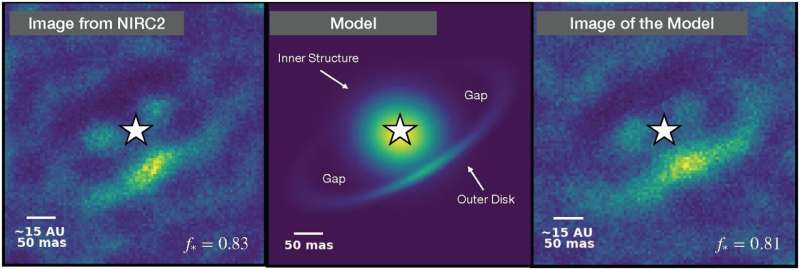Science
Astronomers Unveil New Insights into Planet Formation with SPAM

Astronomers at the W. M. Keck Observatory in Hawaiʻi have made significant strides in understanding how planets form by examining the dusty regions surrounding young stars. Their latest findings focus on a star known as HD 34282, providing a closer look at the processes that lead to planetary birth. The research was published in The Astrophysical Journal on November 5, 2025.
Using the observatory’s advanced Near-Infrared Camera (NIRC2), the team was able to penetrate the thick gas and dust enveloping HD 34282, which lies approximately 400 light-years from Earth. This star is surrounded by a “transition disk,” a region believed to be shaped by the gravitational influence of forming planets.
Exploring Planetary Nurseries
Lead author Christina Vides, a graduate student at the University of California Irvine, highlighted the study’s importance in tracing the origins of planetary systems. “We all want to know where we came from and how our solar system formed,” she stated. The team’s observations revealed clumpy structures and brightness patterns in the disk, which suggest potential planet-forming activity, even though no confirmed protoplanets were directly observed.
The findings offered unprecedented constraints on the possible locations of young planets within the disk, along with estimates of the star’s mass and accretion rate. These data are vital for understanding how surrounding materials might coalesce into planets over time.
Rare Discoveries in Planet Formation
Detecting protoplanets is a challenging endeavor. To date, only PDS 70 b and PDS 70 c, both imaged in 2020 using the same NIRC2 instrument, have been confirmed as protoplanets. Each new observation builds on this legacy, advancing scientists’ knowledge of how planetary systems develop from swirling disks of gas and dust.
“This work is pushing the boundaries of what we can see,” Vides remarked. The observatory’s advanced adaptive optics and masking capabilities enable astronomers to resolve details just a few astronomical units from the star, areas that would otherwise remain hidden.
Looking to the future, the team plans to expand their research to include other young stars with promising disks. They are also preparing for upcoming observations with next-generation instruments like SCALES, a high-contrast imager currently being developed for the observatory. This technology will allow for even more detailed investigations into protoplanets.
“Every new system we study helps us understand a little more about how planets form and evolve,” Vides explained. The ability to observe conditions conducive to the birth of new worlds, even from hundreds of light-years away, is a remarkable achievement in the field of astronomy.
For more detailed insights, refer to the study by Christina L. Vides et al, titled “NIRC2 Interferometric Imaging of the HD 34282 Transition Disk’s Small Grain Structure,” published in The Astrophysical Journal.
-

 Science3 weeks ago
Science3 weeks agoIROS 2025 to Showcase Cutting-Edge Robotics Innovations in China
-

 Lifestyle3 weeks ago
Lifestyle3 weeks agoStone Island’s Logo Worn by Extremists Sparks Brand Dilemma
-

 World3 weeks ago
World3 weeks agoBravo Company Veterans Honored with Bronze Medals After 56 Years
-

 Politics3 weeks ago
Politics3 weeks agoJudge Considers Dismissal of Chelsea Housing Case Citing AI Flaws
-

 Health3 weeks ago
Health3 weeks agoStartup Liberate Bio Secures $31 Million for Next-Gen Therapies
-

 Health3 weeks ago
Health3 weeks agoTop Hyaluronic Acid Serums for Radiant Skin in 2025
-

 Top Stories3 weeks ago
Top Stories3 weeks agoIndonesia Suspends 27,000 Bank Accounts in Online Gambling Crackdown
-

 Sports3 weeks ago
Sports3 weeks agoMel Kiper Jr. Reveals Top 25 Prospects for 2026 NFL Draft
-

 World3 weeks ago
World3 weeks agoHoneywell Predicts Record Demand for Business Jets Over Next Decade
-

 Lifestyle3 weeks ago
Lifestyle3 weeks agoMary Morgan Jackson Crowned Little Miss National Peanut Festival 2025
-

 Sports3 weeks ago
Sports3 weeks agoYamamoto’s Mastery Leads Dodgers to 5-1 Victory in NLCS Game 2
-

 Science3 weeks ago
Science3 weeks agoArizona State University Transforms Programming Education Approach









